Evenos is a township located in Provence, near Toulon. It is divided into three villages: Le Broussan, Sainte Anne d'Evenos (the modern village in the valley)... |
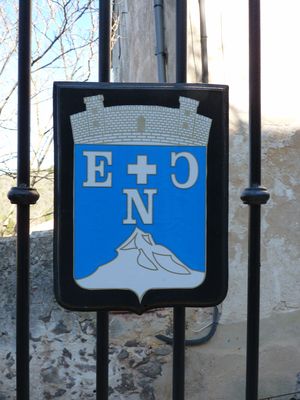 |
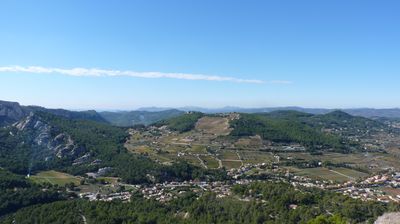 |
... and Evenos (the medieval village)
|
|
|
|
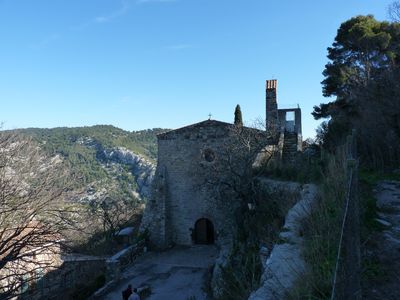
Evenos Roman church
|
| THE CASTLE |
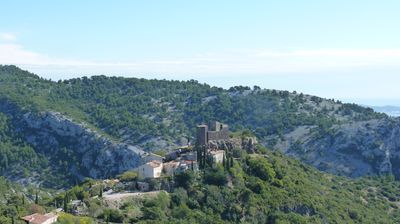
|
Evenos feudal Castle dates back to the 11th century. It was a very dissuasive castle due to his geographic position. Indeed, it was built on cliffs. |
The castle's dungeon is remarkable regarding its medieval military architecture. Its spur, we can say its stem, is turned toward the north. |
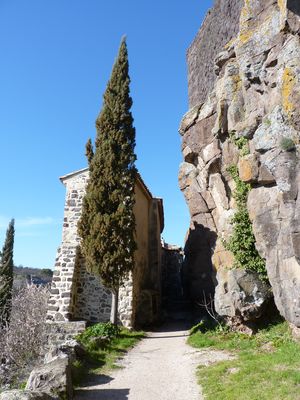
The castle's technical situation is explained by the geographical lie of the land. Indeed, the walls perfectly follow the stone and we can wonder how engineers managed to build a castle on stone with so perfect a precision.
|
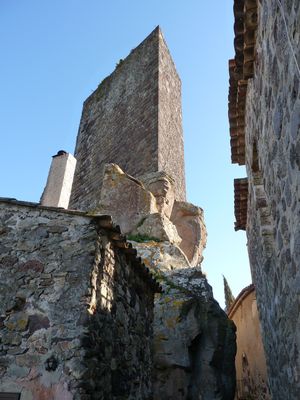 |
The basalt walls were in fact built according to a technique called bossage. It consisted in cutting a stone with straight edges and leaving the centre round. Here is an example of bosse.
When a projectile hit the stone, the stone wouldn't burst, the projectile would rebound.
|
|
 Example of corbel
Example of corbel |
The castle is composed of two main parts: the dungeon and the housing quarters.
The dungeon as in all the les fortified castles is the highest and the best protected part. It consists on the one hand of the spur with the chapel and the upper terrace and on the other hand the guardroom and its terrace. |
A little history
In the 9th century, because of Barbarian raids, the inhabitants of San Estevo build a wooden castle on the former Roman oppidum.
In the 11th century Marseille viscounts transform the wooden castle into the fortified castle we can still see today.
In 1296 the lordships of Evenos and Ollioules separate which leads to a population growth in Evenos. Consequently, the first enclosure is not sufficient to hold all the dwellings. Houses are built under the dungeon.
In the 16th century Thomas Lords have become Lords of Evenos and Orves. The medieval castle is in poor condition. It is transformed into a more comfortable one.
In 1592, during 4 days, the castle is besieged by Lesdiguières. He is the leader of the Protestants fighting Catholic villages of Provence for Henry IV, hence the legend of the pig.
|
The Legend of the Pig
In 1592, the village of Evenos was besieged by Lesdiguières. The castle was defended by Ollioules's Captain Isnard. After four days of shelling, Lesdiguières was still outside the village and the supplies were beginning to diminish. So Captain Isnard gathered his companions and imagined a stratagem to drive the invader away. He took the last bag of corn and the last pig still alive. He force-fed it with the corn and he let it walk freely on the parapet walk. Lesdiguières' soldiers caught it, killed it and disembowelled it to eat it. But when they saw the corn in its stomach and they brought the pig to Lesdiguières. The latter said: "there are probably lots of supplies in this castle otherwise they wouldn't have fed this pig with corn." Finally, disgusted, Lesdiguières left and returned to his country. |
|
The Three Leaps of the Devil and Saint Martin
This is a question we could ask people living in Evenos or Ollioules: "Have you ever seen "St Martin's footprint"' near the Ollioules Gorges, in this place called "La Kakoya"?"
A very long time ago, the Devil reigned all over the surrounding country. Peasants committed murders and the Devil would take their souls to Hell. St Martin heard about this and came to Provence to help this country terrorized by this Devil to get rid of it. The Devil made a deal with him: they would play "the three leaps". The winner would be the one who would make the longest jump. St Martin began and after three monstrous leaps, he arrived at the Kakoya with such strength, that he left a footprint on the stone. The Devil laughed and began to leap far away. After one leap, he arrived at "Gros Cerveau", after the second one, he reached Cap-Gros: he would probably reach Six-Fours with his third leap! Realizing he was about to lose, St Martin prayed God to help him. The devil was stopped right away by the wind and fell down into the Ollioules Gorges. St Martin had won.
|
The Legend of the White Lady
Once upon a time, Lady Sybille lived in Evenos. She was lovely, gentle and she was the Lord's spouse. This brutal lord would spend ages on his horse and hunting deer in the forests. But one day, a minstrel got to the castle. He was hosted in the South tower above the Destel. The lord was hunting, Sybille was languishing and the minstrel was singing. Finally, what was supposed to happen happened: Sybille fell in love with the minstrel. She met him in the tower during her husband's shooting parties. But one day, a storm forced the lord back to the castle earlier than expected. He found his wife in the minstrel's arms. Furious with anger, he stabbed the minstrel with his hunting knife before hurling him over the castle walls. But Lady Sybille, out of shame or despair, hurled over the window to meet her lover. Nowadays, during stormy nights, we can still see Sybille dressed in white, walking near the White Tower. |
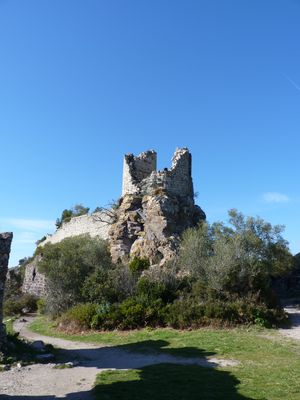 The White Tower
The White Tower |
|
There are two rooms in this cave, the "new room" and the room of "Marteau Pilon" and also two siphons. The first one (siphon.2 on the cross section) is 12.5 metres deep and the second one (siphon.1on the cross section) is 14.50 metres deep.
|
La Foux is a river flowing through Ste Anne d'Evenos.
It is also the name of a cave which is five hundred metres long and ends by a lake. |
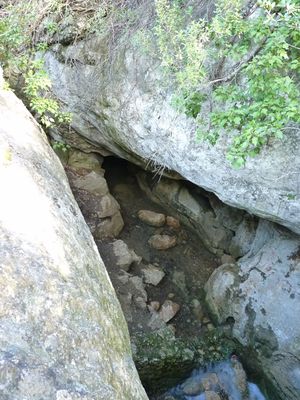 The entrance of the cave
The entrance of the cave |
It's not a large cavity but we can easily cross this cave, except maybe near the last siphon, where the passage becomes very low and narrow.
The floor of the cave is covered with sand.
|
|
|
When the weather is stormy and showery the water fills the cave creating a spring that merges with the river called La Reppe. Man tamed these waters and built a mill. |
Now, it's very easy to enter the cavity, so it is regularly degraded by young people who have no respect for their environment. To stop that, the speleologists try to give the cave its original aspect back. They teach the future generations to respect the environment. |
|
This cave has a story, the flow of water used to be permanent, but a few decades ago it stopped. At the beginning of the century the spring of La Foux suddenly turned red and muddy for several days. Since then the flow has never been the same again.
The speleologists are trying to find an explanation to understand this strange phenomenon. They have done a lot of research, they have explored and studied the cave. But the mystery remains. Some people think that this disappearing is associated with the legend of Iero Profundado...
|
The Legend of Iero Profundado
We are on the 26th of July, the day when the village of Evenos celebrates its patroness St Anne. This piece of land belongs to a peasant. When it's harvest time, he comes with his two horses and presses his wheat. Some neighbours, on their way to pray their patroness St Anne, walk past him. They call out to the peasant and say:
"Come with us, come and pray Sainte Anne, your land will be more fertile!" |
|
|
But the peasant only answers with insults and blasphemies. The whip continues to crack. The peasant persists in his hard work. |
Later, when the neighbours walk past the field again, they only see a big round hole where earlier on the peasant was working. This hole is now know as Iero Profundado; "Iero Profundado" means "engulfed, swallowed up air". |
|
If you decide to walk in the area on the night of the 26th of July, you can still hear the neighing of the horses and the blasphemies and insults of the peasant coming from the ground.
|
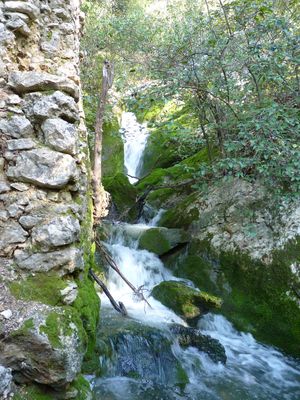
La Foux, the river |
Lots of people also say that since that day, La Foux, the river flowing in the village, has stopped flowing regularly. What's for sure is that the area was certainly above the river and that after that the water was lost or sidetracked. |
THE CAVES OF GASPARD DE BESSE |
Going down Ollioules Gorges, on the banks of the Reppe River, one can notice the aperture of a cave.
This cave named after Gaspard de Besse is highly unlikely to have been used by the most famous Provencal bandit as it was not strategically placed.
Gaspard de Besse, was born to a humble family and grew up to become one of the South of France's legends. His real name was Gaspard Bovis or Bouis. He was from Besse hence his nickname: Gaspard de Besse. His main adventure as a famous criminal started in 1776.
He used many different hiding places in Ollioules Gorges in order to be able to attack the coaches carrying rich traders and wealthy aristocrats. The most famous one is the Garou Cave situated at the entrance of the gorges viewing the Beausset's plain. It consists of three parts: a main area, a second part higher than the first one and another part totally invisible from the outside. From this point, he had a wonderful view and could easily plan his attacks.
He was extremely agile and was able to move from place to place with great speed so that people even believed he was ubiquitous.
He reminds us of Robin Hood and his merry men, because he used many of the same tactics and also it is believed that he stole from the rich to give to the poor without using violence. He personally never used a fire arm and never killed his victims. |
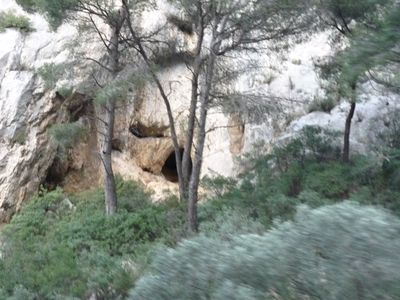 |
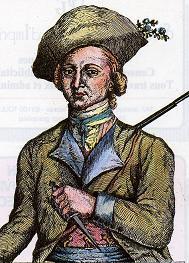
|
A great example of one of his attacks was when he and his men blocked the road with rocks, when the carriage arrived the travellers got out to move the rocks and Gaspard's men pretended to help them. Meanwhile Gaspard discreetly got into the carriage and stole all the valuables.
Another one of his most spectacular acts, took place in the castle of "Font-blanche". Indeed, during a sumptuous feast, Gaspard, incognito, dressed as a wealthy gentleman managed to penetrate the castle with two of his men. They were armed with guns with only explosive powder just to "frighten and not kill". He entered and apparently said to the crowd "I have been told that you ladies have heard stories of a terrifying man called Gaspard de Besse. I am here to introduce him to you". He was given refreshments and then he charmed the noble and rich traders and proceeded to steal their most precious possessions.
Gaspard de Besse was arrested in 1780. He was then judged and sentenced to death in 1781. Along with his comrades, he was hung, drawn and quartered and then his head was chopped off and exposed at the "Taillade" forest to dissuade other bandits. Finally, Gaspard, was buried in the plain of "Cuges-les-pins" but his legend lives on. |